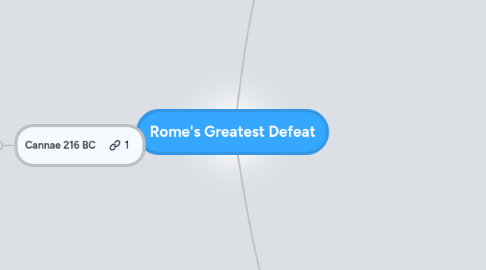
1. Cannae 216 BC
1.1. Took place in Cannae Italy in 216 BC
1.2. The Military Leaders
1.2.1. Hannibal (Carthiginian)
1.2.1.1. A very strong leader, grown in a military family.
1.2.1.2. Strategy consisted of head on attacks and bloody battles.
1.2.2. Paullus and Varro (Roman)
1.2.2.1. Paullus had a hit and run strategy to wear Hannibals army out.
1.2.2.2. Varro had a Hannibal style strategy and preferred head on battles.
1.2.2.3. Both were appointed by the Roman republic to lead. They would alternate which one was in charge every day.
1.3. Battle Results
1.3.1. Number of Soldiers
1.3.1.1. Romans
1.3.1.1.1. 40,000 Roman infantry
1.3.1.1.2. 40,000 Allied infantry
1.3.1.1.3. 2,000 Roman cavalry
1.3.1.1.4. 4,000 Allied cavalry
1.3.1.2. Carthage
1.3.1.2.1. 32,000 Heavy infantry
1.3.1.2.2. 8,000 Light infantry
1.3.1.2.3. 10,000 cavalry
1.3.2. Effects
1.3.2.1. Killed
1.3.2.1.1. Romans
1.4. Advantages/Disadvantages
1.4.1. Hannibal
1.4.1.1. Know your enemy, know yourself.
1.4.1.2. Had a smaller Army than that of the Romans
1.4.1.3. Usage of double envelopment against the Romans. Surrounding them into a trap.
1.4.2. Paullus and Varro
1.4.2.1. Alternate leadership.
1.4.2.2. Varro's overconfidence and temper overtook him and he lead his men into a trap blindly.
2. Adrianople 378 AD - Modern Day Thrace
2.1. The Military Leaders
2.1.1. Fridigern (Gothic)
2.1.1.1. Used the newly developed weapons to his advantage and in his tactics
2.1.1.2. Gothic tribe leader
2.1.1.3. Knew Roman tactics
2.1.2. Valens (Roman)
2.1.2.1. Emperor of Eastern Rome, believed in traditional stlye tactics
2.1.2.2. Helped the Goths settle in Roman territory but underestimated their numers
2.1.2.3. Wanted glory for himself, didn't wait for reinforcements from the West
2.2. Number of Soldiers
2.2.1. Romans
2.2.1.1. 15,000-20,000 or 25,000-30,000
2.2.2. Goths
2.2.2.1. 12,000-15,000 or 20,000-25,000
2.3. Advantages/Disadvantages
2.3.1. Romans
2.3.1.1. Underestimated the enemy's strength
2.3.1.2. Cavalry was only used to protect infantrymen
2.3.2. Goths
2.3.2.1. Many were once trained by the Roman Army
2.3.2.2. Had a strong bulky cavalry
2.4. Effects
2.4.1. Exposed Rome as not being invincible
2.4.2. Inspired other barbarian tribes to attack Rome
2.4.3. Eventually led to the downfall of the Western empire
2.4.4. Death of Roman emperor Valens
3. Teutoburg Forest 09 AD
3.1. The Military Leaders
3.1.1. Arminius (Germanic)
3.1.1.1. Former Roman soldier, knew their tactics
3.1.1.2. Was familiar with the Germanic tribes
3.1.2. Varus (Roman)
3.1.2.1. Corrupt former governor of Syria
3.1.2.2. Arrogant and didn't listen to others
3.2. Effects
3.2.1. The Roman's expansion was stopped
3.2.2. The Germanic tribes were more feared by the Romans
3.2.3. The Roman emporer, Augustus, was very disturbed
3.3. Number of Soldiers
3.3.1. Romans
3.3.1.1. 20,000-30,000 (3 Roman Legions)
3.3.2. Germanic Tribesmen
3.3.2.1. 12,000-32,000 (exact number unknown)
3.4. Advantages/Disadvantages
3.4.1. Romans (Varus)
3.4.1.1. More a politician than a battlefield tactician
3.4.1.2. He trusted Arminius as a friend
3.4.1.3. Weather was not on their side. Heavy rain would cause Archers unable to fire their arrows correctly
3.4.2. Germanic tribes (Arminius)
3.4.2.1. Trained by the Romans
3.4.2.2. Had a friendship with the opposing commander Varus. Know your enemy, know yourself.
3.4.2.3. Had the advantage of terrain by use of the Forest they could quickly surround the enemy and quickly retreat into it for cover.
